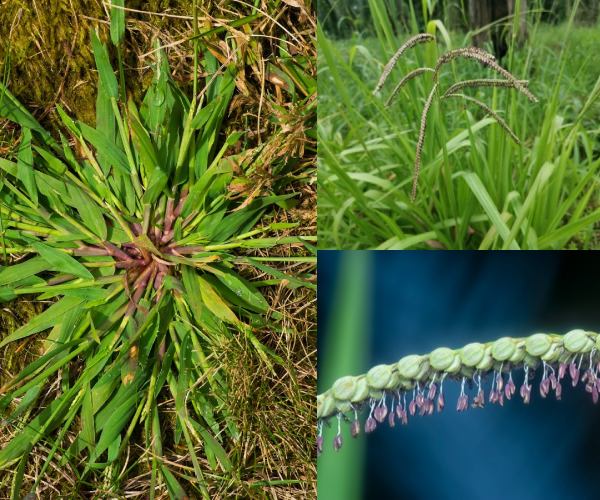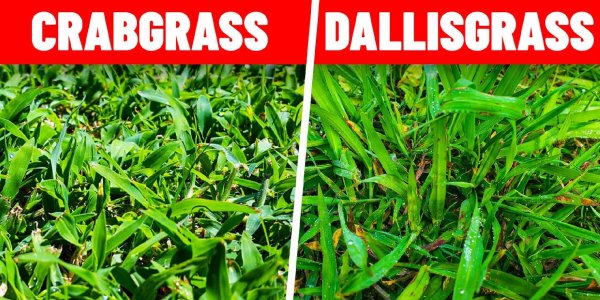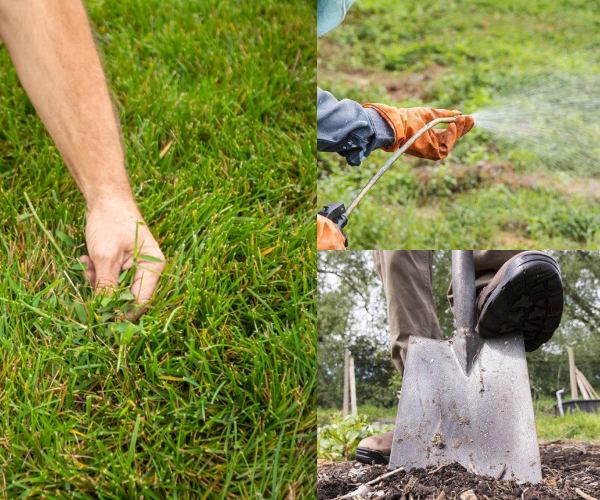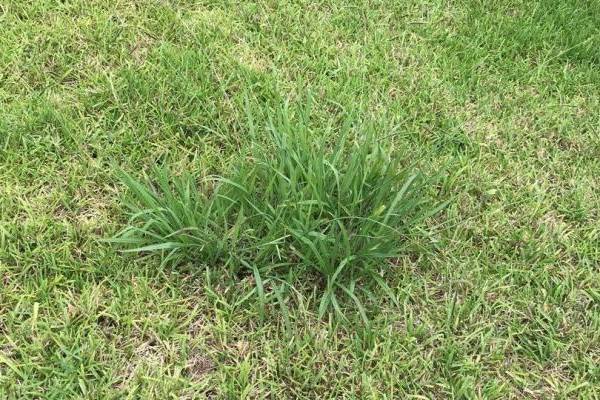Dallisgrass is a common clumpy, perennial grassy weed that can quickly take over lawns, gardens, and landscapes. It grows fast and has deep roots, making it challenging for homeowners to manage. Dallisgrass spreads through seeds and underground stems, so mowing won’t stop it from spreading. Whether you are facing dallisgrass for the first time or have been dealing with it for years, this article will provide you with comprehensive strategies, including both manual and chemical methods, to reclaim your lawn and keep it dallisgrass-free.
Dallisgrass Identification: How to Spot This Pesky Weed
Dallisgrass, scientifically known as Paspalum dilatatum, is a coarse-textured perennial grass belonging to the Poaceae family. Similarly, its other common name is water grass. It grows in round, tufted clumps, making it a distinctive sight in any landscape. Dallisgrass is native to Brazil, Uruguay, and Argentina, but now it is found everywhere and often takes over lawns, golf courses, and city landscapes. It grows fast and spreads quickly with its rhizomes, which can make it a problem weed in some places. Here are some key characteristics of dallisgrass that can help you spot it in your lawn.
Dallisgrass Appearance
- Dallisgrass has a coarse appearance with abundant, blade-shaped leaves that can be as tall as 3 feet.
- The leaves are yellow-green and have a white line down the middle. The lower parts of the leaves have some hair, but the flat parts don’t have any hair.
- Similarly, it has a very distinct seedhead that looks like a “Y” with three to six spikelets per branch.
- The spikelets are covered in soft hairs. Whereas, flowers are produced on a tall stalk at the top, which has 3-5 or more branches, each about 2-3 inches long.
- Dallisgrass thrives in warm, wet places and is commonly found in lawns, gardens, and roadsides.

Root System Characteristics
To identify Dallisgrass apart from its features, understand its roots.
- Dallisgrass has a fibrous root system that can go one meter deep under the soil.
- It consists of short rhizomes, which can root quickly and easily, allowing it to spread throughout the landscape.
Dallisgrass vs. Crabgrass: Understanding the Differences
Dallisgrass and Crabgrass have similar appearances, but, they differ significantly in their life cycles and control methods. Let’s explore their distinctions,
Leaf Texture – Dallisgrass is known for its rough leaves and wide blades, growing in clumps and spreading through seeds and rhizomes. On the other hand, crabgrass has finer leaves and spreads close to the ground, creating mats. When it comes to color, crabgrass tends to have a bluish-green hue, while dallisgrass typically appears in a lighter shade of green.
Seed Head – Dallisgrass and crabgrass also differ in their seed head characteristics. Crabgrass seed heads are small and fine, emerging from the top of the stems. Dallisgrass seed, on the other hand, heads are larger and often feature small black spots, growing along the sides of the stems.
Growth Habits – Dallisgrass and crabgrass have distinct growth habits. Dallisgrass tends to grow in clumps and spreads through seeds and rhizomes, while crabgrass spreads low to the ground, forming mats.
Germinations – Dallisgrass and crabgrass also differ in their germination patterns. Dallisgrass typically germinates from seeds and regrows from clumps, sods, and seeds. In contrast, crabgrass primarily spreads through the germination of its seeds, which are produced in large quantities, providing it with ample opportunities to grow each year.
Control Methods – Controlling dallisgrass and crabgrass involves different methods. Pre-emergent herbicides are effective against crabgrass seeds, preventing them from sprouting. In contrast, controlling dallisgrass often requires post-emergent herbicides or manual removal, as pre-emergent herbicides are typically ineffective against its persistent growth from rhizomes and seeds.
Lifespan – Dallisgrass is a perennial grass that grows back each year from the same root system, while crabgrass is an annual that germinates from seeds and dies within the same year.

How to Kill Dallisgrass: Step-by-Step Guide
Here is a simple guide to getting rid of dallisgrass using various methods, such as manual removal, chemical treatments, or eco-friendly approaches.
Manual Method: Uprooting Dallisgrass by Hand
The best way to remove dallisgrass from your yard is by manually digging them out with a shovel or by hand. Here is a step-by-step guide to killing dallisgrass without using harsh chemicals.
- First, you need to identify dallisgrass by its coarse leaves and wide blades. Make sure not to harm nearby plants.
- Needed to wear gloves to protect your hands from any sharp objects.
- Use a hand tool to dig around the bottom of the dallisgrass clump. This is often best to pull or dig out plants when the soil is moist so the roots can slide out of the soil more easily.
- Gently uproot dallisgrass, making sure to dig beneath the plant to take out the root from the soil, instead of just pulling it or cutting the leaves.
- Dispose of the extracted dallisgrass to prevent regrowth.
Chemical Solutions: Herbicides for Dallisgrass Control
If you have too much dallisgrass in your yard and nothing else is working, you could try a chemical weed killer. For dallisgrass control, herbicides are commonly used. These chemicals are specifically formulated to target and control dallisgrass, offering a reliable solution for those struggling to manage this stubborn weed in their lawns or landscapes. Pre-emergent herbicides like dithiopyr and oryzalin target germinating rhizomes, while post-emergent options such as CMA, glyphosate, foramsulfuron, or MSMA tackle established plants. Here is a step-by-step guide on effective dallisgrass control.
- Pre-emergent herbicides should be applied in the spring before seeds start germinating.
- Use a selective herbicide labeled for dallisgrass to keep your lawn healthy.
- Follow the manufacturer’s instructions for application and safety precautions.
- Similarly, apply the herbicide directly to the dallisgrass, targeting the foliage.
- Repeat the application as necessary, following the herbicide’s recommended schedule for optimal control.
- Monitor the treated area for any regrowth and reapply herbicide as needed.

Natural Remedies: Eco-Friendly Dallisgrass Killers
Here are some eco-friendly solutions for dallisgrass control, offering alternatives to chemical herbicides and reducing environmental impact. These natural remedies provide effective ways to prevent dallisgrass in your lawn while being kinder to the environment.
- One way is solarization, using clear plastic to trap heat and kill weeds like dallisgrass.
- Another is using natural weed killers with ingredients like vinegar or citric acid. They kill weeds but are safer for the environment.
- Also, regular mowing can weaken dallisgrass by stopping it from making seeds.
- Watering, fertilizing, and planting good grass can also help stop dallisgrass.
Frequently Asked Questions
1. What is the best way to get rid of dallisgrass?
The best way to remove dallisgrass from your yard is by manually digging them out with a shovel or by hand. Besides, you can also use various methods including chemical solutions and eco-friendly approaches to prevent to dallisgrass.
2. What is the difference between crabgrass and dallisgrass?
Dallisgrass is a perennial grass that grows back each year from the same root system, while crabgrass is an annual that germinates from seeds and dies within the same year. Similarly, they differ significantly in their life cycles and control methods.
3. What is the scientific name of dallisgrass?
The scientific name of dallisgrass is Paspalum dilatatum.
Also read, All You Need To Know About Polka Dot Plants – Growth, Care, Tips, and More
